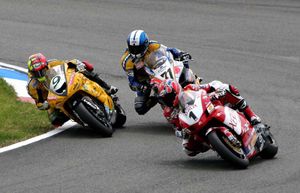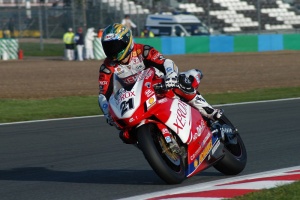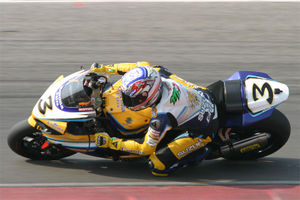Superbike World Championship
| FIM Superbike World Championship | |
|---|---|
| Current season | 2009 World Superbike season |
| Teams | 7 manufacturers (Ducati, BMW, Aprilia, Honda, Kawasaki, Suzuki, Yamaha) |
| Sport | Motorcycle sport |
| Founded | 1988 |
| Country | Worldwide |
| Champion | |
Superbike World Championship (also known as SBK) is the premier worldwide Superbike racing Championship. the championship was founded in 1988. The Superbike World Championship season consists of a series of rounds held on permanent racing facilities. Each round has 2 races and the results of each race are combined to determine two annual World Championships, one for riders and one for manufacturers
Europe is Superbike World Championship's traditional centre and leading market. However, rounds are also held in Qatar and Australia. In 2008 the championship will also return to the United States for the first time since 2004, and in Indonesia for the first time since 1997
The championship is regulated by the FIM the governing body of motorcycle racing and managed and promoted by FGSport.
History

The Superbike World Championship began in 1988, being open to modified versions of road bike models available to the public. For many years, the formula allowed for machines with 1000 cc V-twin engines (principally Ducati, but later Aprilia and Honda) to go up against the 750 cc four-cylinder engines (Honda, Yamaha, Kawasaki and Suzuki). For the first few seasons Honda with the RC30 was winning but gradually the twins got the upper hand. Having 250cc advantage benefited Ducati and it was able to dominate the championship for many years. From 1993 to 1999 Carl Fogarty and Ducati dominated, Fogarty won the title a record 4 times and finished runner up 2 times
Realizing that they could not overcome the 250 cc advantage, Honda introduced its own v-twin powered motorcycle the VTR1000/RC51 in 2000. The result was clear right away as Colin Edwards won the championship in the bike's first year of competition. Ducati regained the title in 2001 with Troy Bayliss. Colin Edwards won the title back in 2002 in what is likely the most impressive comeback in the history of motorcycle racing. During these years the Superbike World Championship reached the zenith of its popularity, with full of factory support and global fan support.
2003 - 1000 cc engines
Main article 2003 World Superbike season
In 2003 the FIM changed the rules to allow 1000 cc machines (either twins, triples or four-cylinder) to race. The recent rule changes in MotoGP to allow 4-stroke engines meant that the Japanese manufacturers had focused their resources there leaving the Superbike World Championship with limited factory involvement (only Ducati and Suzuki).
2003 also saw the entry of Carl Fogarty’s Foggy Petronas FP1. The bike was developed under the previous regulations and was powered by a 3 cylinder 900cc engine. As a result of most of the field being Ducati motorcycles the championship was given the derogatory title of "the Ducati Cup". The Factory Ducati Team entered the only 2 Ducati 999's in the field, taking 20 wins from 24 races in a season where all races were won by Ducati. Neil Hodgson won the title on a Factory Ducati.
2004 - control tyres
Main article 2004 World Superbike season
In an effort to create a more competitive field in 2004 organizers announced a series of changes to the championship. The most significant of the changes was that from 2004 the teams have had to run on Pirelli control tyres. The decision to award the control tyre to Pirelli was controversial. The Pirelli tyres were nowhere near the present standard of Dunlop and Michelin that most of the teams had been using. Dunlop looked to take legal action against the decision while Pirelli claimed that their Michelin and Dunlop were also asked if they would be interested in the one-make tyre rule contract.
Partly as a result of the control tyres, MSMA (Aprilia, Ducati, Honda, Kawasaki, Suzuki and Yamaha) announced that no MSMA teams would participate in the Superbike World Championship, later modifying their statement allowing Ducati to participate.
Though no factory bikes were entered a few privateers choose to run Japanese bikes in 2004. Ten Kate Honda with Chris Vermuelen as its rider, won races and actually contended for the title that eventually was won by James Toseland and Ducati.
2005 - Japanese return

Main article 2005 World Superbike season
Following Ten Kate Honda's success Japanese motorcycles made a return in 2005 with major teams from all four Japanese manufacturers run through European importer’s teams. Troy Corser won the 2005 championship giving Suzuki its first World Superbike title.
2006 - Bayliss back on superbikes

Main article 2006 World Superbike season
2006 saw the return of Australian Troy Bayliss in Superbike World Championship after 3 years in MotoGP. The combination of Bayliss and Ducati proved unstoppable and they dominated the season winning 12 races. Honda's James Toseland and Yamaha's Noriyuki Haga battled for second with the British rider coming on top. Defending champion Troy Corser on a Suzuki was 4th. The 2006 season gave the feeling that World Superbike was “back” following the years of decline in 2003 and 2004.
2007 - Superbike return to glory
Main article 2007 World Superbike season
With MotoGP machines reduced in capacity from 990 cc to a 800 cc maximum displacement, 1000 cc Superbikes, both at World Championship and top national championships (AMA Superbike and British Superbike) become the most powerful racing bikes being road raced in 2007. While superbikes remain two or more seconds per lap slower than MotoGP bikes at most tracks they have equal or even more power.
Troy Bayliss defended his title riding once again a Ducati 999. Even though production of the 999 ended in 2006 and the bike was replaced by the Ducati 1098, Ducati produced 150 limited edition 999s to satisfy homologation requirements. Bayliss main rivals in his title defense included former MotoGP rider Max Biaggi riding a Suzuki, 2004 champion James Toseland riding a Honda and Noriyuki Haga riding a Yamaha
The combination of some boring races in MotoGP and some thrilling races in SBK saw the championship's popularity increase even more.
The championship was wrapped up by James Toseland in the very last race of the season. His 415 points put him 2 points ahead of Haga with Biaggi following along with 397 points.
2008 - 1200 cc twins
Main article 2008 World Superbike season
After introducing the Ducati 1098 in 2007 powered by a 1098 cc v-twin engine Ducati requested that Superbike rules be changed to allow v-twins of up to 1200 cc compete against 1000 cc four-cylinder bikes. Ducati argued that they no longer produced a road-going 1000 cc V-twin superbike and that the level of tuning now needed to make their 999 competitive on the race track was too expensive. Ducati said they would quit if the rules were not changed, Alstare Suzuki team boss Francis Batta also said that his team would quit if the new rules gave Ducati an unfair advantage.
The FIM eventually included the 1200 cc displacement limit for twins in the 2008 superbike rules. According to the new rules twin motorcycles will be 6 kg heavier than four cylinders (168 kg to 162 kg) and will also have a 50 mm air restrictor fitted. The weight limit and the intake-restrictor size of twin machines will be updated, if needed, during the Championship, by a system analysing the race points obtained.
The new rules also changed the minimum number of bikes required to acquire homologation. For 2008 and 2009, all manufacturers, regardless of total production numbers, must produce a minimum of 1000 bikes to acquire homologation. From 2010 onwards, the minimum production number will be increased to 3000 bikes. In the past, smaller manufacturers were allowed to build as few as 150 bikes to meet the homologation requirements. Manufacturers took advantage of this by producing 'homologation specials'--highly tuned versions of their road bikes with performance parts designed especially for racing.
Riders
See also List of Superbike World Championship racers
Riders from all over the world compete in the Superbike World Championship. The championship is perhaps most closely followed in Italy because of Ducati and the United Kingdom where superbike racing has been the most popular form of motorcycle racing. Rider from Australia and the United States have traditionally been successful in the championship. For the last couple of years however no American riders have competed in the championship.
British rider Carl Fogarty is the most successful rider in the championship's history winning the championship 4 times and a total of 59 race wins.
Many riders such as Colin Edwards and Chris Vermeulen have used the Superbike World Championship as a stepping stone to entering MotoGP, James Toseland will also move to MotoGP in 2008. Other riders such as Max Biaggi and Alex Barros came to SBK as an alternative when they were unable to secure MotoGP rides.
Except for the Frenchman Raymond Roche, who won the championship in 1990, all other Superbike World Champions were English native speakers.
Superbike motorcycles
Superbike racing motorcycles are derived from standard production models. In the past however manufacturers took advantage of loopholes in the rules to create "homologation specials", motorcycles with low production numbers made especially for racing.
motorcycles that raced in the Superbike World Championship include
- Ducati: 851,888,916,996,998,999
- Honda: RC30,RC45,RC51,CBR1000RR
- Yamaha: FZR750,YZF750,YZF-R7,YZF-R1
- Kawasaki: ZXR750,ZX-7RR,ZX-10R
- Suzuki: GSX-R750,GSX-R1000
- Bimota: YB4EI,SB8R
- Aprilia: RSV1000
- Petronas: FP1
- Benelli: Tornado Tre 900
- MV Agusta: MV Agusta F4 1000
Race weekend
- Friday
- 1st free practice (60 minutes) and 1st qualifying (60 minutes)
- Saturday
- 2nd qualifying (60 minutes) and 2nd free practice (60 minutes)
- The times of 1st and 2nd qualifying are combined and the 16 fastest riders qualify for Superpole. The rest receive a grid position based on lap time, starting with 17th. To qualify for the race, riders must record a lap time no longer than 107% of the time recorded by the pole-position rider.
- Superpole
- Riders go out one by one in reverse order of qualifying position; in Superpole, riders may use a qualifying tyre. If Superpole is declared wet, a 50-minute session takes place for all 16 riders to set timed laps; each rider may complete no more than 12 laps including in and out laps.
- Sunday
- Warm-up (20 minutes) Race 1 and Race 2
- Race distance must be from a minimum of 90 km to a maximum of 110 km.
Point system
| Position | 1 | 2 | 3 | 4 | 5 | 6 | 7 | 8 | 9 | 10 | 11 | 12 | 13 | 14 | 15 |
| Points | 25 | 20 | 16 | 13 | 11 | 10 | 9 | 8 | 7 | 6 | 5 | 4 | 3 | 2 | 1 |
- For the Manufacturers' Championship, only the highest finishing motorcycle by a particular manufacturer is awarded the points for that position.
Support classes
Supersport World Championship
Template:Main Supersport World Championship has been a support class to the Superbike World Championship since 1999
To be eligible for World Supersport,a motorcycle must have a four stroke engine of between 400 and 600cc for four cylinder machines, and between 600 and 750 cc for twins and must satisfy the FIM homologation requirements. World Supersport regulations are much tighter than in World Superbikes. The chassis of a supersport machine must remain largely as standard, while engine tuning is possible but tightly regulated. As in world superbike a control tyre is used, although supersport regulations dictate that the tyres must be road legal and therefore slicks are not allowed. A world supersport race takes place at every world superbike round.
FIM Superstock 1000 Cup
The FIM Superstock 1000 Cup is a support class to the Superbike World Championship at the European rounds. Motorcycles with the same displacement as superbikes can run is superstock 1000 (though 1200 cc twins were allowed for 2007). Superstock rules are much more restrictive and most components on the bike remain stock. The bikes run on Grooved Pirelli tyres. The Superstock 1000 championship is open to riders up to 24 years of age.
European Superstock 600 Championship
The European Superstock 600 Championship is is a support class to the Superbike World Championship at the European rounds. The championship uses 600 cc production motorcycles and is reserved for riders between 15 and 20 years of age. Same rules as Superstock 1000 apply.
GSX-R European Cup
The GSX-R European Cup is a “one make” series running Suzuki GSX-R750 motorcycles and supports the Superbike World Championship in 6 European rounds. Riders that did not turn 23 before the 1st of January with up to 3 years professional racing career can take part. The cup is organized by Alstare and Suzuki and the cup winner gets a place at FIM Superstock 1000 Cup or European Superstock 600 Championship with Alstare Suzuki
Videogames
PlayStation and PC
- Superbike 2000 (EA Sports)
PC, PS2, PS3, PSP and Xbox 360
- SBK-08 - Superbike World Championship (Black Bean Games) (announced)
External links
- worldsbk.com World Superbike Championship official website
- worldsbk.tv World Superbike Championship official video website
- fim.ch Fédération Internationale de Motocyclisme (FIM), The governing body of motorcycle racing website
- gruppofg.com FGSport, Superbike World Championship promoters website
- [1] Superbike Photos (Creative Commons License)
|
1988 • 1989 • 1990 • 1991 • 1992 • 1993 • 1994 • 1995 • 1996 • 1997 • 1998 • 1999 • 2000 • 2001 • 2002 • 2003 • 2004 • 2005 • 2006 • 2007 • 2008 |





